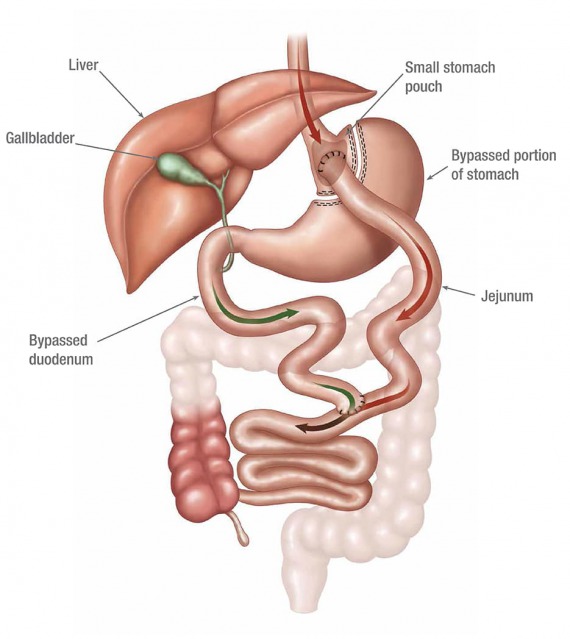Gastric bypass surgery aids in weight loss by changing how your stomach and small intestine handles the food you eat. After the surgery, you stomach will be smaller and you will feel full with significantly less food. Additionally, the food you eat will no longer go into some parts of your stomach and small intestine that absorb food, which means that you will not be getting all of the calories from the food that you are eating. So, eating less plus not absorbing all of the calories that you are eating will set you up for rapid weight loss.
Maybe you’re wondering what gastric bypass surgery would be like? It will likely take only 2 to 4 hours and you will be given a general anesthetic before the surgery—you will be sleeping peacefully and pain free during the procedure. There are two steps during gastric bypass surgery: 1) your surgeon will use staples to divide your stomach to a smaller upper section and larger bottom section. The top part of your stomach (called the “pouch”) is where the food you eat will go. The pouch is about the size of a walnut! And it only holds about one ounce of food—leading to eating MUCH less and losing weight. 2) next, your surgeon will connect a small portion of your small intestine to a small hole in your pouch. The food you eat will now be able to travel from the pouch and into this new opening and then into the small intestine. Because of this rerouting, your body will absorb fewer calories from the food you’re eating. Gastric bypass can be done in two ways. First, by inserting a tiny camera called a laparoscope into your belly. Your surgeon will need to make 4 to 6 small incisions in your belly, where the camera and surgical instruments are then inserted in the cuts. This allows the surgeon to see inside your belly and to preform the procedures discussed above. Using the laparoscope, you should have a shorter hospital stay and recovery. You should also have smaller scars and risks of infections or hernias. The recovery is also said to be less painful. The second way gastric bypass can be done is with open surgery. Your surgeon would make a larger surgical cut to open your belly—then he would preform the bypass procedure.
What would you be looking at in regards to recovery? Recovery time largely depends on the size and amount of incisions made. If you had the procedure done with a laparoscope, you will probably be in the hospital for 2-3 days. If you had the open surgery, your hospital stay could be a bit longer. The areas of incision will be sore in the days following your surgery, but you will be given medication to help bring relief. Make sure to take your medicine! You will also be put on a post-op diet. It will start out as clear liquids only (that will be all you can handle!) and will then progress to pureed foods and protein shakes. After your stomach gets used to that, you will start incorporating soft foods, and then finally back to solid foods. You will be given a strict schedule to follow and it is important to follow it as closely as possible. You will also need to make sure to attend all of your follow up appointments, so you can ask any question you may have and so you can be ensured you are recovering properly.
By now, you might be wondering why gastric bypass surgery is the most popular weight loss surgery…First of all, you will lose weight. On average, you will loose 70% of your excess body weight in the first 18 months after surgery. You could also improve or eliminate type 2 diabetes and other obesity related health conditions. High blood pressure and/or high cholesterol medication can be eliminated. Your hormones may be shifted from the weight loss and it could increase your metabolism long term. And lastly, long term weight loss success—most studies show that 90% of patients maintains at least 50% of excess weight loss after surgery. And once you lose weight and reduce medication intake, it should become much easier to exercise and be more active. If you implement exercise plus healthy eating, you could lose even more than the average weight loss listed above.
Now let’s discuss a few disadvantages and risks of gastric bypass surgery. First, it can lead to long term vitamin/mineral deficiencies (particularly in Vitamin B12, iron, calcium, and folate). It requires strict adherence to dietary recommendations, life-long vitamin/mineral supplementation, and consistent follow-up visits. Some other risks are gastritis (inflamed stomach lining), heartburn, and/or ulcers. Vomiting and nausea can occur if you eat more than your pouch can hold. And lastly, possible scarring inside your belly that could lead to a blockage in your bowels in the future.
Based off the high success and satisfaction rates, the benefits seem to far outweigh the risks, but that is your decision to make. If this surgery doesn’t feel like the right fit for you, continue reading the next blogs. We will be discussing three more weight loss procedures.
Are you a candidate? Start here
Intro: Should I consider weight loss surgery?
Series article #2: Gastric Bypass Surgery – Everything you want to know (and more)
Series article #3: Sleeve Gastrectomy – Everything you want to know (and more)
Series article #4: The Duodenal Switch (DS) – Everything You Want to Know (and more)



